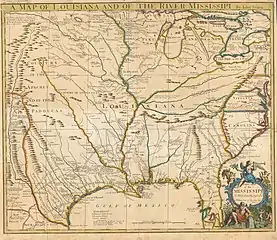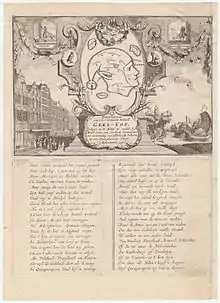Mississippi Company
The Mississippi Company (French: Compagnie du Mississippi; founded 1684, named the Company of the West from 1717, and the Company of the Indies from 1719[1]) was a corporation holding a business monopoly in French colonies in North America and the West Indies. In 1717, the Mississippi Company received a royal grant with exclusive trading rights for 25 years.[2] The rise and fall of the company is connected with the activities of the Scottish financier and economist John Law who was then the Controller General of Finances of France. Though the company itself started to become profitable and remained solvent until the collapse of the bubble,[3] when speculation in French financial circles and land development in the region became frenzied and detached from economic reality, the Mississippi bubble became one of the earliest examples of an economic bubble.
| Type | Public |
|---|---|
| Industry | International trade |
| Founded | 1684 |
| Founders | Louis XIV |
| Defunct | 1721 |
| Fate | Bankrupt |
| Headquarters | France |

In France, the wealth of Louisiana was exaggerated in a marketing scheme for the newly formed Mississippi Company, and its value temporarily soared to the equivalent of $6.5 trillion today, which would make it the second most valuable company in history behind the Dutch East India Company. Meanwhile, a joint-stock company in Britain, known as the South Sea Company, was granted a monopoly to trade with South America. It was eventually worth $4.3 trillion in modern currency.[4]
History

The Compagnie du Mississippi was originally chartered in 1684 by the request of René-Robert Cavelier (de La Salle) who sailed in that year from France with a large expedition with the intention of founding a colony at the mouth of the Mississippi.[5] The expedition did not succeed in this goal; they actually founded a settlement in the vicinity of present-day Victoria, Texas, but even this was short-lived.[6]
In May 1716, Scottish economist John Law, who had been appointed Controller General of Finances of France under the Duke of Orléans, created the Banque Générale Privée ("General Private Bank"). It was one of the first European financial institutions to develop the use of paper money.[7][8][9] It was a private bank, but three-quarters of the capital consisted of government bills and government-accepted notes. In August 1717, Law bought the Mississippi Company to help the French colony in Louisiana. In the same year Law conceived a joint-stock trading company called the Compagnie d'Occident (The Mississippi Company, or, literally, "Company of [the] West"). Law was named the Chief Director of this new company, which was granted a trade monopoly of the West Indies and North America by the French government.[10] The company was involved in the Atlantic slave trade, importing African slaves to Louisiana.[11]
Banque Royale
The bank became the Banque Royale (Royal Bank) in 1718, meaning the notes were guaranteed by the king, Louis XV of France. The company absorbed the Compagnie des Indes Orientales ("Company of the East Indies"), the Compagnie de Chine ("Company of China"), and other rival trading companies and became the Compagnie Perpétuelle des Indes on 23 May 1719 with a monopoly of French commerce on all the seas. Simultaneously, the bank began issuing more notes than it could represent in coinage; this led to a currency devaluation, which was eventually followed by a bank run when the value of the new paper currency was halved.[12]

Mississippi Bubble
Louis XIV's long reign and wars had nearly bankrupted the French monarchy. Rather than reduce spending, the Duke of Orléans, Regent for Louis XV, endorsed the monetary theories of Scottish financier John Law. In 1716, Law was given a charter for the Banque Royale under which the national debt was assigned to the bank in return for extraordinary privileges. The key to the Banque Royale agreement was that the national debt would be paid from revenues derived from opening the Mississippi Valley. The Bank was tied to other ventures of Law – the Company of the West and the Companies of the Indies. All were known as the Mississippi Company. The Mississippi Company had a monopoly on trade and mineral wealth. The Company boomed on paper. Law was given the title Duc d'Arkansas.
Early French colony
In 1699 the French formed the first permanent European settlement in Louisiana (New France), at Fort Maurepas. They were under the direction of Pierre Le Moyne d'Iberville.
The first capital of New France from 1702 until 1711 was La Mobile, after which the capital was relocated to the site of present-day Mobile, Alabama.
In 1718, there were only 700 Europeans in Louisiana. Bénard de la Harpe and his party left New Orleans in 1719 to explore the Red River. In 1721, he explored the Arkansas River. At the Yazoo settlements in Mississippi he was joined by Jean Benjamin who became the scientist for the expedition.
The Mississippi Company arranged ships to bring in 800 more settlers, who landed in Louisiana in 1718, doubling the European population. Law encouraged some German-speaking people, including Alsatians and Swiss, to emigrate. They gave their names to the German Coast and the Lac des Allemands in Louisiana.
Prisoners were set free in Paris from September 1719 onwards, and encouraged by Law to marry young women recruited in hospitals.[13] In May 1720, after complaints from the Mississippi Company and the concessioners about this class of French immigrants, the French government prohibited such deportations. However, there was a third shipment of prisoners in 1721.[14]
Speculation
Law exaggerated the wealth of Louisiana with an effective marketing scheme, which led to wild speculation on the shares of the company in 1719. The scheme promised success for the Mississippi Company by combining investor fervor and the wealth of its Louisiana prospects into a sustainable joint-stock trading company. The popularity of company shares was such that they sparked a need for more paper bank notes, and when shares generated profits the investors were paid out in paper bank notes.[15] In 1720, the bank and company were merged and Law was appointed by Philippe II, Duke of Orléans, then Regent for Louis XV, to be Comptroller General of Finances[16] to attract capital.
Downfall
Law's pioneering note-issuing bank thrived until the French government was forced to admit that the number of paper notes being issued by the Banque Royale exceeded the value of the amount of metal coinage it held.[17]
The market price of company shares eventually reached the peak of 10,000 livres. As the shareholders were selling their shares, the money supply in France suddenly doubled, and inflation burgeoned. Inflation reached a monthly rate of 23% in January 1720.[18]
Opponents of the financier attempted to convert their notes into specie (gold and silver) en masse, forcing the bank to stop payment on its paper notes.[19]
The "bubble" burst at the end of 1720.[18] By September 1720 the price of shares in the company had fallen to 2,000 livres and to 1,000 by December. By September 1721 share prices had dropped to 500 livres, where they had been at the beginning.
By the end of 1720 Philippe d'Orléans had dismissed Law from his positions. Law then fled France for Brussels, eventually moving on to Venice, where his livelihood was gambling. He was buried in the church San Moisè in Venice.[12]
See also
- Richard Cantillon – banker who made an early profit from the company
- South Sea Bubble
- List of trading companies
- European chartered companies founded around the 17th century (in French)
References
- "The French Period". Jewell's Crescent City Illustrated. Cultural Center of the Inter-American Development Bank. Archived from the original on 9 October 2012. Retrieved 1 July 2013.
- John Ceuvas, Cat Island, History of the Mississippi Coast Page 11
- Lanchester, John (29 July 2019). "The Invention of Money". The New Yorker. ISSN 0028-792X. Retrieved 12 June 2023.
- "MARKETSThe Most Valuable Companies of All-Time". VisualCapitalist. 26 September 2023.
- Bryan Taylor, The Mississippi Bubble, or How the French Eliminated All Their Government Debt (So Why Can’t Bernanke?) globalfinancialdata.com -- October 9, 2013
- Weddle, Robert S. (30 October 2011). La Salle's Texas Settlement. Retrieved 4 November 2015.
{{cite encyclopedia}}:|work=ignored (help) - Nevin, Seamus (2013). "Richard cantillon – The Father of Economics". History Ireland. 21 (2): 20–23. JSTOR 41827152.
- Backhosue, Roger. Economists and the economy: the evolution of economic ideas, Transaction Publishers, 1994, ISBN 978-1-56000-715-9, p. 118
- http://libertystreeteconomics.newyorkfed.org/2014/01/crisis-chronicles-the-mississippi-bubble-of-1720-and-the-european-debt-crisis.html NY Federal Reserve: Mississippi Bubble of 1720
- Bammer, Stuart. Anglo-American Securities Regulation: Cultural and Political Roots, 1690–1860, Cambridge University Press, 2002, ISBN 978-0-521-52113-0, p. 42
- Kleen, Michael (2017). Witchcraft in Illinois: A Cultural History. Arcadia. ISBN 9781625858764.
- Sheeran, Paul and Spain, Amber. The international political economy of investment bubbles, Ashgate Publishing, Ltd., 2004, ISBN 978-0-7546-1997-0, p. 95
- Hardy, James D. Jr. (1966). "The Transportation of Convicts to Colonial Louisiana". The Journal of the Louisiana Historical Association. 7 (3): 207–220. JSTOR 4230908.
- Cat Island: The History of a Mississippi Gulf Coast Barrier Island, by John Cuevas
- Beattie, Andrew. "What burst the Mississippi Bubble?" on Investopedia.com (17 June 2009)
- Mckay, Charles. Extraordinary Popular Delusions and the Madness of Crowds. New York: Noonday Press, 1932, p. 25. First edition published 1841, second edition 1852
- "Mississippi Company".
-
Moen, Jon (October 2001). "John Law and the Mississippi Bubble: 1718–1720". Mississippi History Now. Archived from the original on 1 March 2016. Retrieved 26 April 2021.
Law devalued shares in the company in several stages during 1720, and the value of bank notes was reduced to 50 percent of their face value. ... The fall in the price of stock allowed Law's enemies to take control of the company by confiscating the shares of investors who could not prove they had actually paid for their shares with real assets rather than credit. This reduced investor shares, or shares outstanding, by two-thirds.
- Davies, Roy and Davies, Glyn. "A Comparative Chronology of Money: Monetary History from Ancient Times to the Present Day: 1700–1749" (1996 and 1999)
Further reading
- Pollard, S. "John Law and the Mississippi Bubble." History Today (September 1953) 3#9 pp. 622–630.
- Gleeson, Janet (2001). Millionaire: The Philanderer, Gambler, and Duelist Who Invented Modern Finance. New York: Simon & Schuster. ISBN 978-0684872957.
External links
- "Learning from past investment manias" (AME Info FN).
- . Collier's New Encyclopedia. 1921.
- . New International Encyclopedia. 1905.